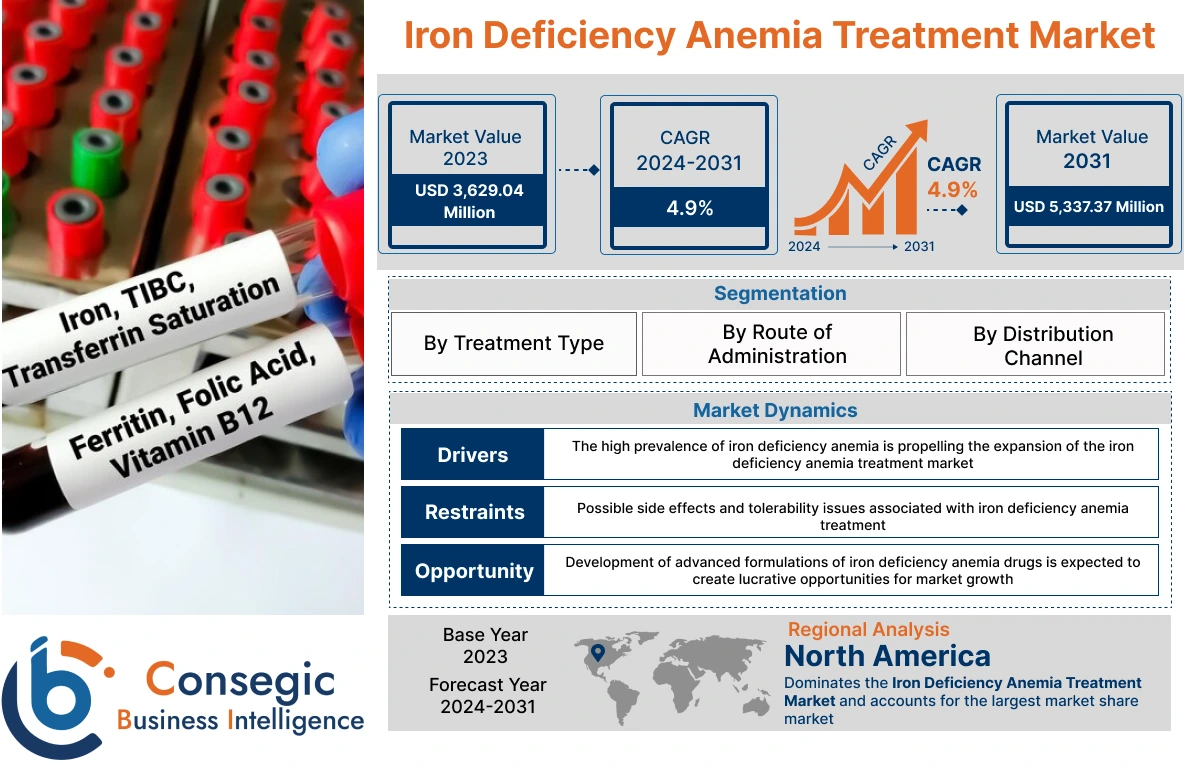Iron Deficiency Anemia Treatment Market Size :
Consegic Business Intelligence analyzes that the iron deficiency anemia treatment market size is growing with a CAGR of 4.9% during the forecast period (2023-2031). The market accounted for USD 3,629.04 million in 2023 and it is projected to be valued at USD 5,337.37 Million by 2031.
Iron Deficiency Anemia Treatment Market Scope & Overview :
Iron deficiency anemia is a condition that occurs when there is a lack of iron in the body to produce hemoglobin, which is the protein responsible for carrying oxygen in the body. The condition eventually leads to a lack of oxygen supply to the organs and tissues causing symptoms such as pale skin, shortness of breath, cold hands and feet, weakness, and fatigue. Iron deficiency anemia is generally caused because of factors such as insufficient dietary intake of iron, the loss of blood from conditions such as gastrointestinal bleeding or menstruation, and conditions leading to the inability to absorb iron.
Iron deficiency anemia is generally diagnosed through blood tests that include a complete blood count and additional tests such as serum ferritin, iron, and total iron-binding capacity. As per the analysis, the patients suffering from iron deficiency anemia generally have low levels of serum ferritin and iron, and high levels of total iron-binding capacity. The treatment for iron deficiency anemia generally includes the incorporation of iron supplements to increase the iron level in the body. The supplements generally include ferrous sulfate, ferrous gluconate, and ferrous fumarate. Additionally, along with iron supplements, dietary changes including more iron-rich food are necessary for the maintenance and treatment of iron-deficiency anemia treatment. The increasing prevalence of chronic diseases and pregnancy-related anemia are influencing the trends of the market.
How is AI Impacting the Iron Deficiency Anemia Treatment Market?
AI is significantly impacting the iron deficiency anemia (IDA) treatment market by improving the accuracy and speed of diagnosis. AI-powered algorithms analyze blood test results, and even images of fingernails or blood smears, to rapidly and reliably detect iron deficiency and differentiate it from other types of anemia. This allows for earlier intervention. Furthermore, AI is moving into treatment personalization. By analyzing vast amounts of patient data, AI can suggest customized iron supplement dosages and delivery methods, predict potential side effects, and monitor treatment efficacy in real-time. This data-driven approach promises to optimize patient outcomes and reduce the need for in-person clinic visits.
Iron Deficiency Anemia Treatment Market Insights :
Iron Deficiency Anemia Treatment Market Dynamics - (DRO) :
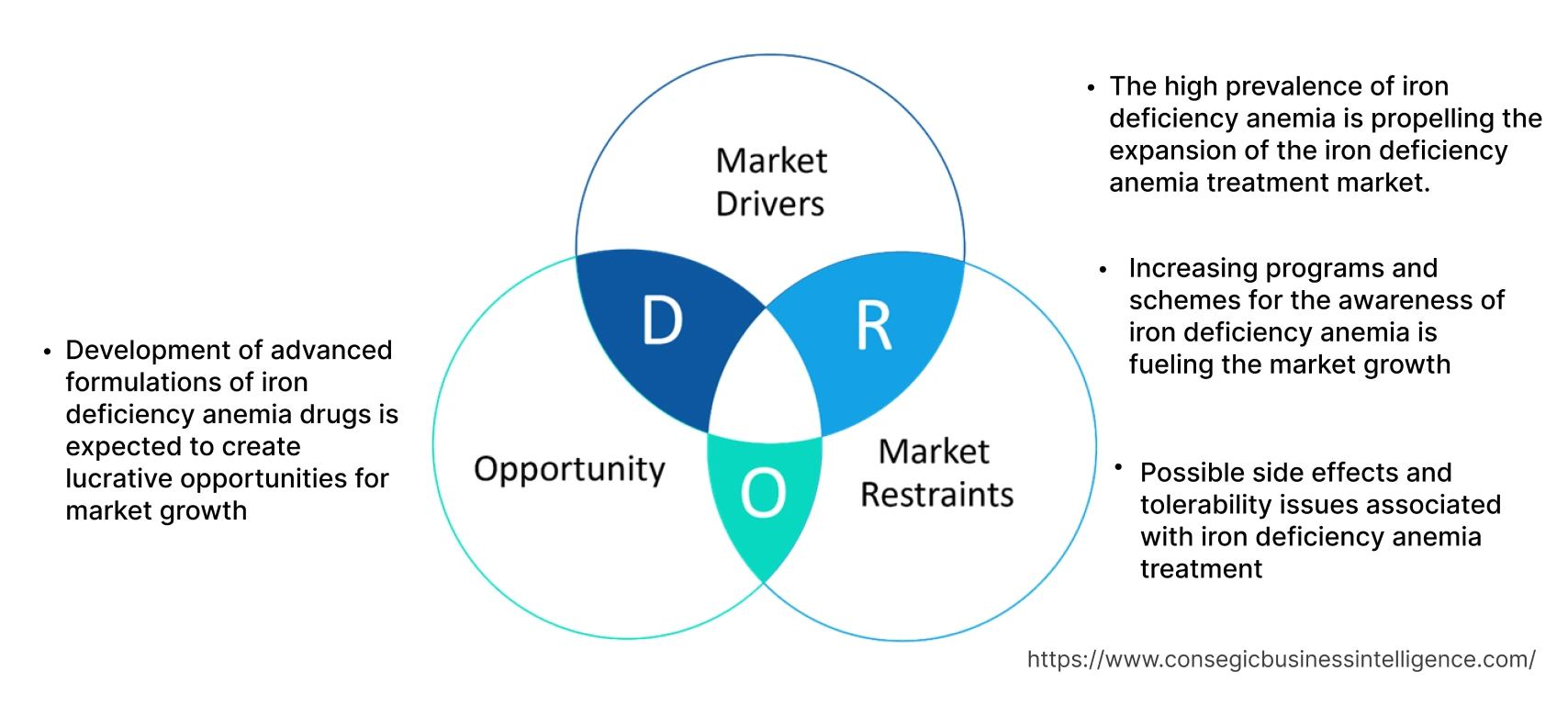
Key Drivers :
The high prevalence of iron deficiency anemia is propelling the expansion of the iron deficiency anemia treatment market
The high prevalence of iron deficiency anemia is significantly driving the iron deficiency anemia treatment market. Iron deficiency anemia is one of the most common nutritional deficiencies that affects people of all ages. Iron deficiency anemia is a condition that is caused because of the lack of iron present in the body. Iron is responsible for the production of haemoglobin which carries oxygen throughout the body. Factors such as inadequate dietary intake of iron, chronic blood loss, certain medical conditions, and poor absorption contribute to the prevalence of iron deficiency anemia.
For instance, According to data provided by research article on the National Library of Medicine, in January 2023, iron deficiency anemia is the most common type of anemia and around 30% of the population is affected by iron deficiency anemia.
Thus, the prevalence of iron-deficiency anemia is boosting the trends of the segment.
Increasing programs and schemes for the awareness of iron deficiency anemia is fueling the market growth.
The market for iron-deficiency anemia treatment is being boosted by an increasing number of programs and schemes aimed at raising awareness about the condition. These initiatives are often implemented by governments, healthcare organizations, and non-profit groups, and focus on educating communities about the importance of iron in maintaining good health and preventing anemia. They also emphasize the importance of preventive measures, such as consuming iron-rich foods and parental supplements for pregnant women, and regular health checkups, to promote early detection and intervention.
By increasing awareness about the signs, symptoms, and causes of iron deficiency, these programs influence individuals to seek diagnosis and treatment for anemia. Based on the analysis, this, in turn, contributes to higher diagnosis rates and treatment-seeking behavior, ultimately influencing the demand for anemia treatment options.
Thus, the rise in awareness programs and schemes is boosting the trends of the market for iron-deficiency anemia treatment.
Key Restraints :
Possible side effects and tolerability issues associated with iron deficiency anemia treatment
The iron deficiency anemia treatment market growth is being hindered due to potential side effects and tolerability issues associated with the treatment. Iron supplements and treatment are effective in treating anemia, but they result in harmful side effects for some individuals. These include gastrointestinal issues such as nausea, constipation, and stomach cramps. Such side effects cause poor patient compliance or discontinuation of treatment, particularly in those with pre-existing gastrointestinal conditions or sensitivities.
Furthermore, based on the analysis, some medications interact with certain components, reducing their effectiveness or causing unwanted side effects. Iron supplements may not be appropriate for individuals with certain medical conditions such as hemochromatosis or chronic inflammatory diseases. Therefore, the issues and side effects linked to iron deficiency treatment are having an impact on the expansion of the market.
Future Opportunities :
Development of advanced formulations of iron deficiency anemia drugs is expected to create lucrative opportunities for market growth
The iron deficiency anemia treatment market has witnessed significant advancement in recent years, with manufacturers focusing on the development of advanced formulations of iron deficiency anemia drugs. Pharmaceutical companies are focusing on developing innovative formulations of iron supplements that minimize gastrointestinal side effects such as nausea, vomiting, abdominal cramps, or constipation. Novel delivery systems such as slow-release formulations and intravenous administration of drugs may be used for the treatment of iron deficiency anemia. Moreover, novel therapies and indications are launched for the treatment of iron deficiency anemia.
For instance, In April 2024, Keylika introduced a novel drug for the treatment of iron deficiency anemia that is available in skin patches. The product aims to improve the safety, efficiency, and tolerability of the drug.
Thus, the development of advanced formulations is creating lucrative trends and iron deficiency anemia treatment market opportunities in the coming years.
Iron Deficiency Anemia Treatment Market Report Insights:
| Report Attributes | Report Details |
| Study Timeline | 2018-2031 |
| Market Size in 2031 | USD 5,337.37 Million |
| CAGR (2024-2031) | 4.9% |
| By Treatment Type | Medications(Ferrous sulfate, Ferrous Gluconate, Ferrous Fumarate, Sodium Ferric Gluconate, Ferric Hydroxide, and Others), Blood transfusions, and Others. |
| By Route of Administration | Oral and Injectable |
| By Distribution Channel | Hospital Pharmacies, Retail Pharmacies, Online Pharmacies, and Others. |
| By Region | North America, Europe, Asia Pacific, Latin America, and Middle East & Africa |
| Key Players | Teva Pharmaceutical Industries Ltd, Zydus Lifesciences Limited, Sandoz AG, PHARMACOSMOS A/S, Fresenius SE & Co. KGaA, Pfizer, Sanofi, F. Hoffmann-La Roche Ltd, Lupin, Csl Vifor, Alkem Laboratories Ltd, and Akebia Therapeutics |
| Geographies Covered | |
| North America | U.S. Canada Mexico |
| Europe | U.K. Germany France Spain Italy Russia Benelux Rest of Europe |
| APAC | China South Korea Japan India Australia ASEAN Rest of Asia-Pacific |
| Middle East and Africa | GCC Turkey South Africa Rest of MEA |
| LATAM | Brazil Argentina Chile Rest of LATAM |
| Report Coverage | Revenue Forecast, Competitive Landscape, Growth Factors, Restraint or Challenges, Opportunities, Environment & Regulatory Landscape, PESTLE Analysis, PORTER Analysis, Key Technology Landscape, Value Chain Analysis, Cost Analysis, and Regional Trends & Forecast |
Iron Deficiency Anemia Treatment Market Segmental Analysis :
By Treatment Type :
The treatment type is categorized into medication, drug transfusion, and others. In 2023, the medications segment accounted for the highest iron deficiency anemia treatment market share of 37.55%, and it is also expected to grow at the highest CAGR over the forecast period. The medication segment is further bifurcated into ferrous sulfate, ferrous gluconate, ferrous fumarate, sodium ferric gluconate, ferric hydroxide, and others. Medications mainly iron supplements are prescribed for the treatment of iron deficiency anemia. These supplements generally offer a primary approach to gaining reduced iron and managing the underlying condition. As per the analysis, oral iron supplements such as ferrous sulfate, ferrous gluconate, and ferrous fumarate are widely prescribed because of their easy availability, cost-effectiveness, and wide availability.
These supplements provide elemental iron, which is absorbed by the gastrointestinal tract and utilized by the body for the production of red blood cells, thus, addressing the route cause of anemia. Intravenous formulations provide a faster way to increase iron levels in the body compared to oral supplements since they are injected directly into the bloodstream. Various formulations are launched for the treatment of iron deficiency anemia.
For instance, In July 2021, Sandoz launched the first generic high-dose intravenous iron, Ferumoxytol Injection, to treat iron deficiency anemia in US patients.
Thus, the use of medication for the treatment of iron deficiency is boosting the expansion of the segment.
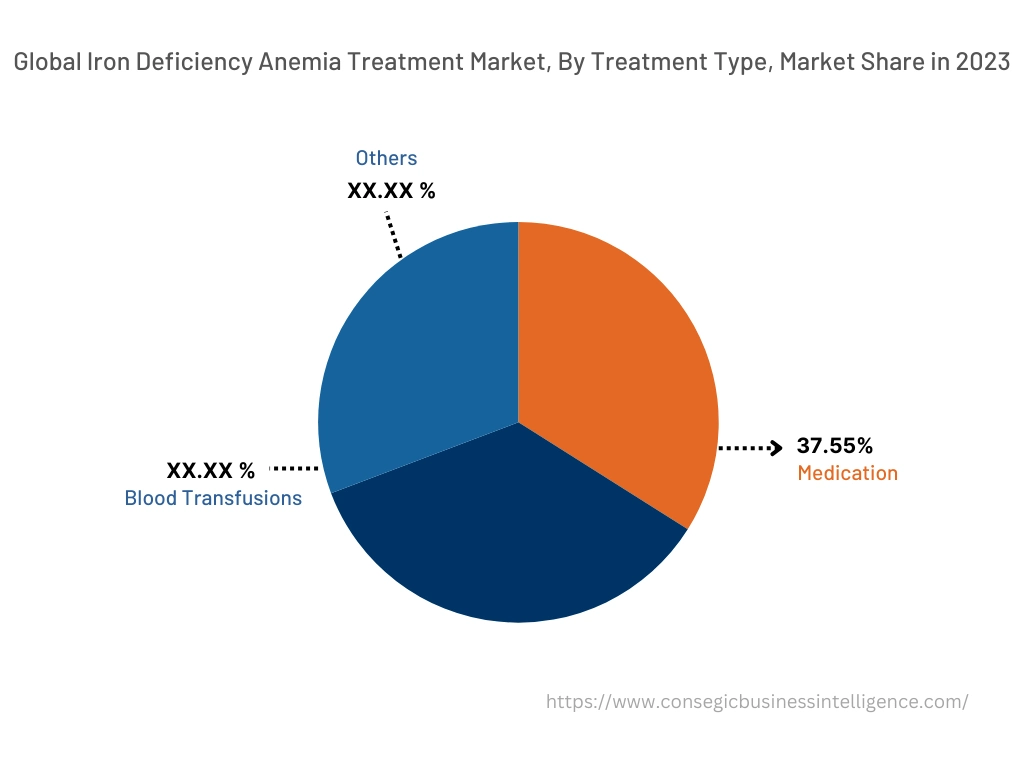
By Route of Administration :
The route of administration segment is categorized into oral and injectable. In 2023, the oral segment accounted for the highest market share in the overall iron deficiency anemia treatment market. The consumption of drugs orally is one of the most common methods for the treatment of iron deficiency anemia. Oral medications such as ferrous sulfate, ferrous gluconate, and ferric citrate are commonly prescribed to manage iron levels in the body. The oral route of administration is used in this method where the medications are taken orally, usually as tablets, capsules, or liquids. This allows the drugs to easily pass through the digestive system and enter the bloodstream, where they subsequently find their way to specific organs or tissues to start working as therapeutics.
The oral route is preferred for its convenience and ease of use for patients, enabling them to take their medication at home without the need for medical supervision. Additionally, as per the analysis, oral medications are typically well tolerated, and the doses are generally adjusted based on individual patient needs and response to treatment. Various oral drugs and systems are launched for the treatment of iron deficiency anemia.
For instance, In March 2023, BioSyent Inc launched FeraMAX Pd Therapeutic 150 is an oral iron medication designed to prevent and maintain iron levels in the body, and for the treatment of iron deficiency anemia.
Thus, the consumption of drugs for the treatment of iron deficiency anemia treatment through the oral route of administration is boosting the expansion of the market.
Furthermore, the injectable segment is expected to hold the highest CAGR over the forecast period. Iron deficiency anemia treatment typically involves the administration of several injectable drugs either intravenously or subcutaneously.
Most of the drugs used for this treatment are developed in injectable form. The intravenous administration of drugs improves the bioavailability of the drugs, which enhances patient safety. Furthermore, based on the analysis, the expansion of this segment is being fueled by increasing advances in technology for injectable drugs.
For instance, In May 2023, Emcure Pharmaceutical launched its injectable for the treatment of iron deficiency anemia. Thus, the above factors are boosting the expansion of the segment.
By Distribution Channel :
The distribution channel segment is categorized into hospital pharmacies, retail pharmacies, online pharmacies, and others. In 2023, the retail pharmacies segment accounted for the highest market share in the overall iron deficiency anemia treatment market. Retail pharmacies play an important role in helping patients with iron deficiency anemia to manage their condition. By providing convenient, affordable, and accessible access to iron deficiency anemia injections and medications, retail pharmacies help patients live healthier and more fulfilling lives. Retail pharmacy stores are easy to access, offer competitive prices on iron deficiency anemia treatment, and can provide patients with information and support on how to use medications safely and effectively. In addition, asper the analysis, they are often the first point of contact for patients with iron deficiency anemia. When patients are diagnosed with iron deficiency anemia, their doctor will typically refer them to a retail pharmacy to pick up their iron supplements and medications. New retail pharmacies are launched for the easy distribution of medications to patients.
For instance, In January 2023, Reliance Retails launched Netmeds retail pharmacies for the distribution of medications. Thus, the high benefits and easy availability of medications across retail pharmacy stores are driving the segment's development worldwide.
Moreover, the online pharmacies segment is expected to hold the highest CAGR over the forecast period. Online pharmacies such as e-commerce websites and company websites provide a platform for customers to purchase medicines and personal care products online, allowing the customer to get iron deficiency anemia drugs in the comfort of their homes within a short time. The increasing sale of pharmaceutical products through e-commerce platforms is expected to provide lucrative growth opportunities for online pharmacies over the forecast period.
For instance, According to the report by the National Investment Promotion and Facilitation Agency in June 2021, the Indian e-pharmacy sales in 2019 accounted for USD 0.5 billion which is expected to reach USD USD 4.5 billion compounded rate of 44%. Thus, the growing e-pharmacy sales are providing lucrative growth opportunities for segment growth over the forecast period.
By Region :
The regional segment includes North America, Europe, Asia Pacific, the Middle East and Africa, and Latin America.
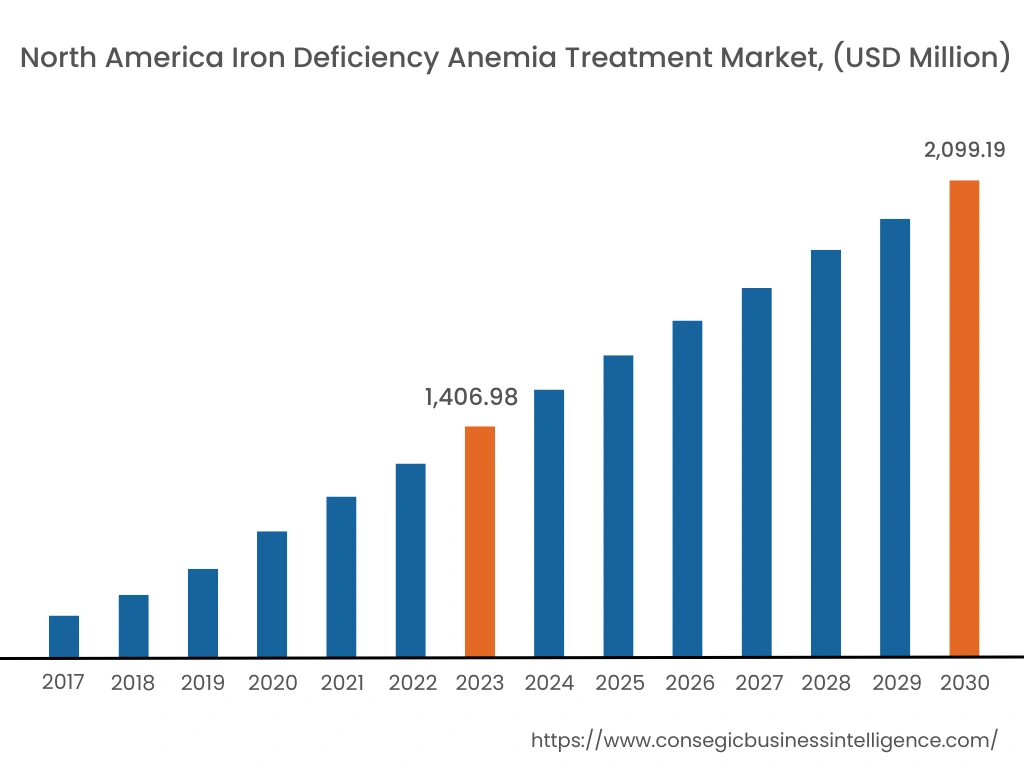
In 2023, North America accounted for the highest market share at 38.77% valued at USD 1,406.98 Million in 2023, it is expected to reach USD 2,099.19 Million in 2031. In North America, the U.S. accounted for the highest market share of 67.35% during the base year of 2023. North America has a well-established healthcare infrastructure, with a high number of hospitals, clinics, and pharmacies. This makes it easy for people with iron deficiency anemia to access iron medications and other essential supplies. Moreover, based on the iron deficiency anemia treatment market analysis, the high prevalence of iron deficiency anemia across the region is driving the trends and iron deficiency anemia treatment market demand across the region.
For instance, The U.S. Department of Health and Human Services, in February 2021, reported that 2% to 5% of females and 1% to 2% of males in the United States suffer from iron deficiency anemia.
Thus, the high prevalence of iron deficiency anemia across the region is driving the demand for iron deficiency anemia treatment market trend across North America. Furthermore, Asia Pacific is expected to witness significant growth over the forecast period, growing at a CAGR of 5.4% during 2023-2031. There is a growing awareness of diabetes management in the Asia Pacific region. This is leading to an increase in the demand for iron deficiency anemia supplements. Furthermore, Governments in the Asia Pacific region are increasing their support for iron deficiency anemia management. This is leading to increased access to iron injection and other essential iron deficiency anemia supplies, which is expected to create lucrative growth opportunities for the iron deficiency anemia treatment market across the region over the forecast period. All these above-mentioned factors are collectively boosting the market for iron deficiency anemia treatment across the Asia Pacific region and creating lucrative growth opportunities and trends for the iron deficiency anemia treatment market in the Asia Pacific region.
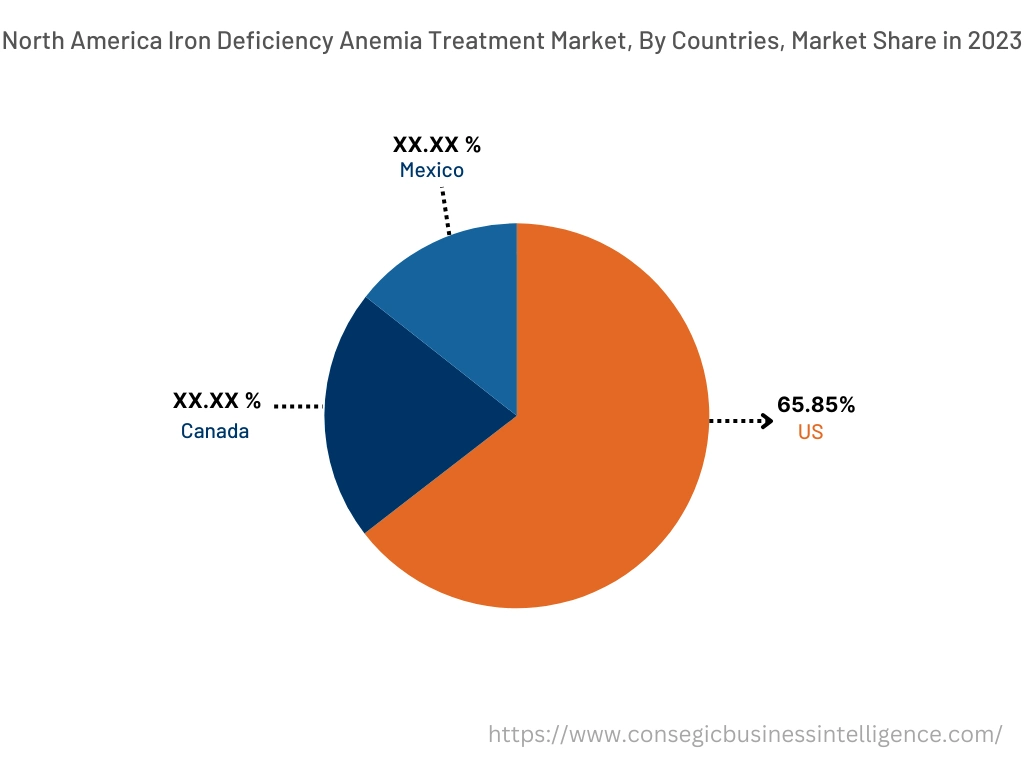
Top Key Players & Market Share Insights :
The global iron deficiency anemia treatment market is highly competitive, with several large players and numerous small and medium-sized enterprises. These companies have strong research and development capabilities and a strong presence in the market through their extensive product portfolios and distribution networks. The iron deficiency anemia treatment industry is characterized by intense competition, with companies focusing on expanding their product offerings and increasing their market share through mergers, acquisitions, and partnerships. The key players in the market include-
The key players in the market include-
- Teva Pharmaceutical Industries Ltd.
- Sandoz AG
- Zydus Lifesciences Limited
- Fresenius SE & Co. KGaA
- Pfizer
- Akebia Therapeutics
- PHARMACOSMOS A/S
- Sanofi
- F. Hoffmann-La Roche Ltd.
- Lupin
- Csl Vifor
- Alkem Laboratories Ltd.
Recent Industry Developments :
- In November 2023, China's National Medical Products Administration (NMPA) has approved Ferinject; for the treatment of iron deficiency in adult patients and patients suffering from iron deficiency in China.
Key Questions Answered in the Report
What was the market size of the iron deficiency anemia treatment market in 2023? +
In 2023, the market size of iron deficiency anemia treatment was USD 3,629.04 million.
What will be the potential market valuation for the iron deficiency anemia treatment industry by 2031? +
In 2031, the market size of iron deficiency anemia treatment will be expected to reach USD 5,337.37 million.
What are the key factors driving the growth of the iron deficiency anemia treatment market? +
Increasing programs and schemes for the awareness of iron deficiency anemia
What is the dominant segment in the iron deficiency anemia treatment market for the distribution channel? +
In 2023, the retail pharmacies segment accounted for the highest market share in overall iron deficiency anemia treatment market.
Based on current market trends and future predictions, which geographical region is the dominating region in the iron deficiency anemia treatment market? +
North America accounted for the highest market share in the overall market.
